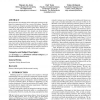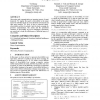252 search results - page 6 / 51 » Artificial Intelligence and Systems Theory: Applied to Coope... |
NICSO
2010
Springer
14 years 2 months ago
2010
Springer
Subsumption architectures are a well-known model for behaviour-based robotic control. The overall behaviour is achieved by defining a hierarchy of increasingly sophisticated behav...
KI
2010
Springer
13 years 5 months ago
2010
Springer
Recognizing human intentions is part of the decision process in many technical devices. In order to achieve natural interaction, the required estimation quality and the used comput...
MAAMAW
1994
Springer
13 years 11 months ago
1994
Springer
One objective of distributed artificial intelligence research is to build systems that are capable of cooperative problem solving. To this end, a number of implementation-oriented ...
ATAL
2008
Springer
13 years 9 months ago
2008
Springer
Recent advances in technology allow multi-agent systems to be deployed in cooperation with or as a service for humans. Typically, those systems are designed assuming individually ...
ATAL
2005
Springer
13 years 9 months ago
2005
Springer
Observation and communication are important aspects of agent teamwork. We employ the agent’s observability as the major means for individual agents to reason about the environme...



